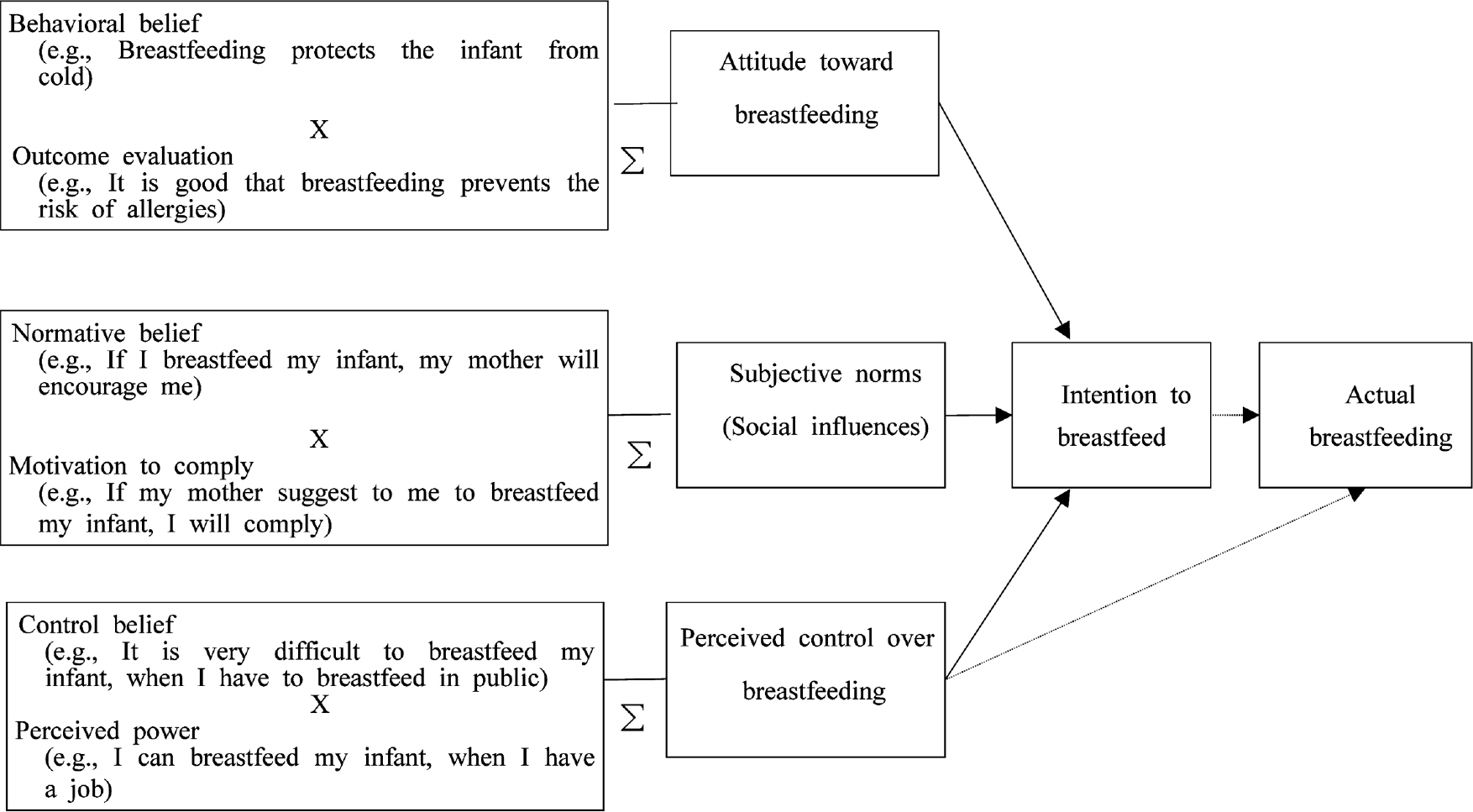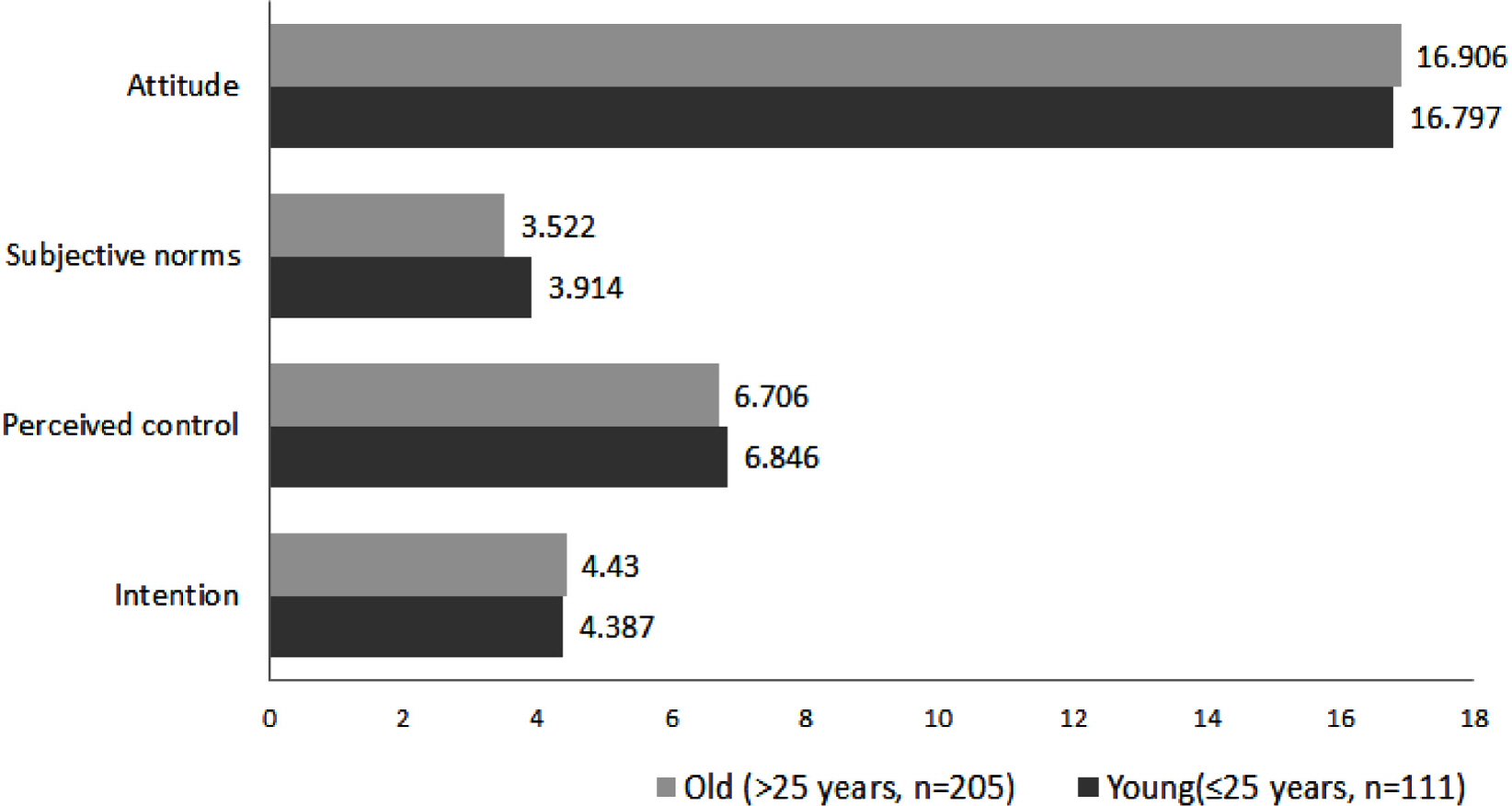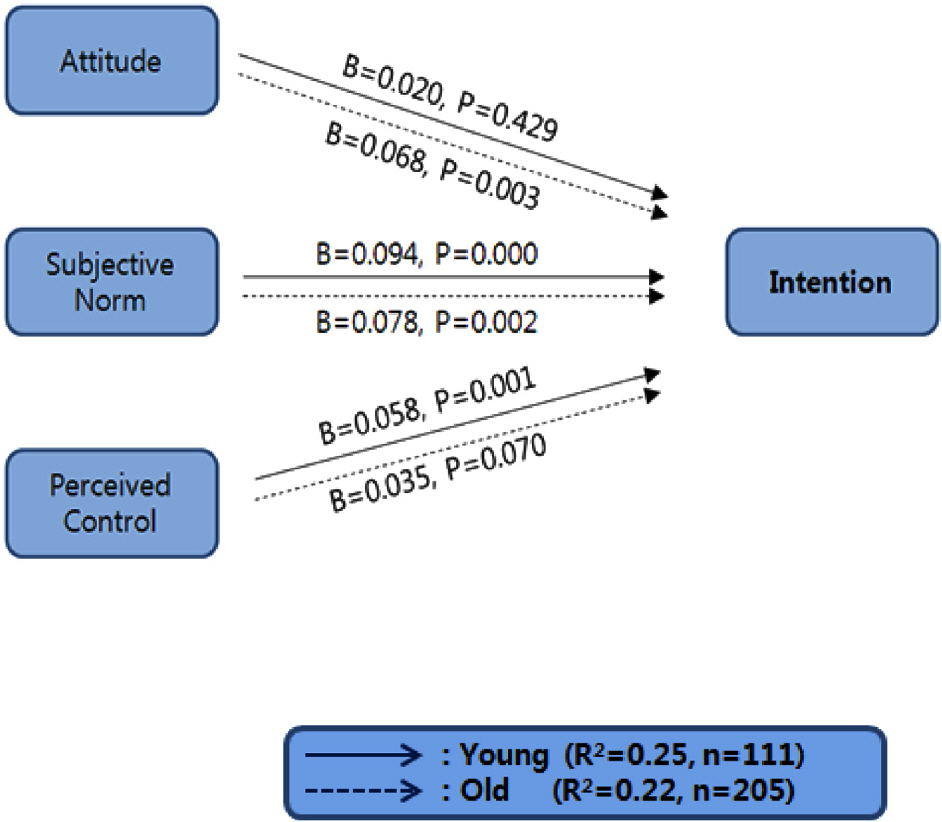J Nutr Health.
2017 Jun;50(3):284-293. 10.4163/jnh.2017.50.3.284.
Belief factors associated with breastfeeding intentions of single women: Based on the theory of planned behavior
- Affiliations
-
- 1Nutrition Education, Graduate School of Education, Sungshin Women's University, Seoul 01333, Korea.
- 2Department of Food and Nutrition, Sungshin Women's University, Seoul 01333, Korea.
- 3Department of Food and Nutrition, Honam University, Gwangju 62399, Korea. jkhil@honam.ac.kr
- KMID: 2386629
- DOI: http://doi.org/10.4163/jnh.2017.50.3.284
Abstract
- PURPOSE
This study was conducted to examine the behavioral intentions of breastfeeding in single women using the theory of planned behavior.
METHODS
The questionnaires were distributed to 350 single women in her 20~30s, and 316 respondents were analyzed by descriptive statistics, Spearman's correlation, and multiple regression analysis.
RESULTS
The subjects showed strong intentions and favorable attitudes toward breastfeeding. The subjects were more favorably influenced by their mothers, siblings, friends, and coworkers who previously experienced breastfeeding than ones with no breastfeeding experiences. There were significant correlations between breastfeeding intention and attitudes (r = 0.321, p < 0.0001), subjective norms (r = 0.434, p < 0.0001), and perceived control (r = 0.307, p < 0.0001). However, regression analysis with two different age groups revealed that subjective norms (p < 0.0001) and perceived control (p < 0.001) contributed to the model of explaining breastfeeding intentions in subjects who were 25 years old or younger, whereas attitudes did not. In addition, subjects who were more than 25 years old showed that attitudes (p < 0.003) and subjective norms (p = 0.002) contributed to the model of explaining breastfeeding intentions while perceived control (p < 0.070) showed less contribution.
CONCLUSION
These results suggest that the theory of planned behavior can be a useful tool to increase the rate of breastfeeding intentions in single women when designing educational materials, which requires consideration of age differences.
Figure
Cited by 3 articles
-
Effects of Educational Intervention about Breastfeeding on University Students' Knowledge and Attitudes toward Breastfeeding: Focusing on Gender Differences
Jo-Yoon Lee
Korean J Community Nutr. 2018;23(1):1-12. doi: 10.5720/kjcn.2018.23.1.1.A Structural Model for Breastfeeding Behavior of First-Time Mothers
Hui Park Seol, Seang Ryu
J Korean Soc Matern Child Health. 2021;25(3):184-196. doi: 10.21896/jksmch.2021.25.3.184.Breastfeeding Success Experience of Primiparas
Sun Ok Lee, Sung Soon Na, Hee Sook Kim, Kyung Eui Bae, Mi Sun Youn, Eun Ju Oh
J Korean Soc Matern Child Health. 2022;26(4):254-269. doi: 10.21896/jksmch.2022.26.4.254.
Reference
-
References
1. Section on Breastfeeding. Breastfeeding and the use of human milk. Pediatrics. 2012; 129(3):e827–e841.2. Nutrition during lactation. In:. Lee HY, Oh SI, Cho HK, Choi MK, Kim MH, editors. editors.Nutrition through the Life Cycle. 2nd ed.Paju: Gyomoonsa;2016. p. 66–91.3. Lee KH, Lee YS. Maternity & women's health nursing I. Revision edition. Seoul: Hyunmoonsa;2011.4. Victora CG, Bahl R, Barros AJ, França GV, Horton S, Krasevec J, Murch S, Sankar MJ, Walker N, Rollins NC. Lancet Breastfeeding Series Group. Breastfeeding in the 21st century: epidemiology, mechanisms, and lifelong effect. Lancet. 2016; 387(10017):475–490.
Article5. Kim SK, Kim YK, Kim HR, Park JS, Son CG, Choi YJ, Kim YW, Lee GE, Yoon AR. The 2012 national survey on fertility, family health & welfare. Seoul: Korea Institute for Health and Social Affairs;2012.6. Ahn HS, Lee Y, Oh YJ. Perception and service needs about nutrition education of pregnant and lactating: to compare with pregnant and lactating women, health specialist and college women. Korean J Community Nutr. 2006; 11(3):327–337.7. Cabieses B, Waiblinger D, Santorelli G, McEachan RR. What factors explain pregnant women's feeding intentions in Bradford, England: a multi-methods, multiethnic study. BMC Pregnancy Childbirth. 2014; 14(1):50.
Article8. Bai Y, Middlestadt SE, Peng CY, Fly AD. Predictors of continuation of exclusive breastfeeding for the first six months of life. J Hum Lact. 2010; 26(1):26–34.
Article9. Choi EY, Park BS, Park SJ. Integrative review of domestic research papers on breast-feeding intervention. J Korea Acad Ind Coop Soc. 2016; 17(1):441–452.
Article10. Jang GJ, Kim SH. Effects of breast-feeding education and support services on breast-feeding rates and infant's growth. J Korean Acad Nurs. 2010; 40(2):277–286.
Article11. Giles M, Connor S, McClenahan C, Mallet J. Attitudes to breastfeeding among adolescents. J Hum Nutr Diet. 2010; 23(3):285–293.
Article12. Giles M, McClenahan C, Armour C, Millar S, Rae G, Mallett J, Stewart-Knox B. Evaluation of a theory of planned behaviour-based breastfeeding intervention in Northern Irish schools using a randomized cluster design. Br J Health Psychol. 2014; 19(1):16–35.
Article13. Giles M, Millar S, Armour C, McClenahan C, Mallett J, Stewart-Knox B. Promoting positive attitudes to breastfeeding: the development and evaluation of a theory-based intervention with school children involving a cluster randomised controlled trial. Matern Child Nutr. 2015; 11(4):656–672.
Article14. Lee SO, Na SS, Park KY. Exclusive breastfeeding rates of breastfeeding-willing mothers and its influencing factors by the 1st, 3rd, and 6th month of postpartum. J Korean Soc Matern Child Health. 2012; 16(1):44–55.15. Ajzen I. The theory of planned behavior. Organ Behav Hum Decis Process. 1991; 50(2):179–211.
Article16. Ajzen I, Fishbein M. Understanding attitudes and predicting social behavior. Englewood Cliffs (NJ): Prentice-Hill;1980.17. Kim JE, Park DY. A study on predicting behavioral intention of breastfeeding among primigravida. Korean J Community Nutr. 2001; 6(3):331–339.18. Swanson V, Power KG. Initiation and continuation of breastfeeding: theory of planned behaviour. J Adv Nurs. 2005; 50(3):272–282.
Article19. Tengku Ismail TA, Wan Muda WA, Bakar MI. The extended Theory of Planned Behavior in explaining exclusive breastfeeding intention and behavior among women in Kelantan, Malaysia. Nutr Res Pract. 2016; 10(1):49–55.
Article20. Jefferson UT. Predictors of breastfeeding attitudes among college-educated African Americans. Res Theory Nurs Pract. 2015; 29(3):189–199.
Article21. Oosterhoff A, Hutter I, Haisma H. It takes a mother to practise breastfeeding: women's perceptions of breastfeeding during the period of intention. Women Birth. 2014; 27(4):e43–e50.
Article22. Cho EA. Knowledge and attitude for breast feeding of middle school students. J Korean Soc Sch Health. 2014; 27(2):69–79.
Article23. Choi KS, Lee HJ. A study on knowledges and attitudes about breast milk feeding and needs for breast milk feeding education among high school students. Korean J Community Nutr. 2006; 11(2):191–204.24. Chuang CH, Chang PJ, Chen YC, Hsieh WS, Hurng BS, Lin SJ, Chen PC. Maternal return to work and breastfeeding: a population-based cohort study. Int J Nurs Stud. 2010; 47(4):461–474.
Article25. Kang NM, Lee JE, Bai Y, Van Achterberg T, Hyun T. Breastfeeding initiation and continuation by employment status among Korean women. J Korean Acad Nurs. 2015; 45(2):306–313.
Article26. Lee JY, Lee KW, Hyun WJ. A study on knowledge and control beliefs regarding breastfeeding of university students by their general characteristics and experienced education in breastfeeding. Korean J Community Nutr. 2013; 18(5):457–466.
Article27. Kim SH, Choi ES, Kim TH. The knowledge and attitude on breast feeding of female university students. J Korean Acad Womens Health Nurs. 2001; 7(1):93–106.
- Full Text Links
- Actions
-
Cited
- CITED
-
- Close
- Share
- Similar articles
-
- Testing the Theory of Planned Behavior in the Prediction and Intention of Smoking Cessation Behavior
- The extended Theory of Planned Behavior in explaining exclusive breastfeeding intention and behavior among women in Kelantan, Malaysia
- Factors Influencing the Intention of Hand Hygiene Compliance among Nursing Caregivers in Long Term Care Facilities: Based on the Planned Behavior Theory
- Prediction of Breastfeeding Intentions and Behavior: An Application of the Theory of Planned Behavior
- Factors Influencing Entrepreneurial Intention of Nursing Students Based on Theory of Planned Behavior




